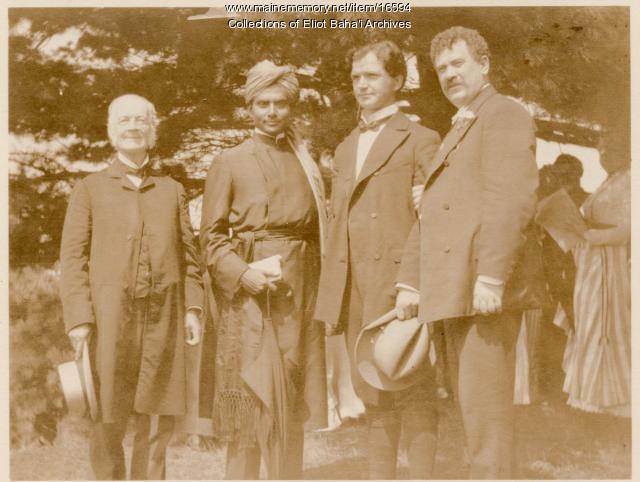Keywords: Green School
Item 6465
Green Acre Fellowship membership card, 1925
Contributed by: Eliot Baha'i Archives Date: 1925-05-29 Location: Eliot Media: Ink on paper
Item 16594
Visitors to Green Acre, Eliot, ca. 1900
Contributed by: Eliot Baha'i Archives Date: circa 1900 Location: Eliot Media: Photographic print
Exhibit
The Advent of Green Acre, A Baha'i Center of Learning
The Green Acre Baha'i School began as Green Acre Conferences, established by Sarah Jane Farmer in Eliot. She later became part of the Baha'i Faith and hosted speakers and programs that promoted peace. In 1912, the leader of the Baha'i Faith, 'Abdu'l-Baha, visited Green Acre, where hundreds saw him speak.
Exhibit
In Time and Eternity: Shakers in the Industrial Age
"In Time and Eternity: Maine Shakers in the Industrial Age 1872-1918" is a series of images that depict in detail the Shakers in Maine during a little explored time period of expansion and change.
Site Page
View collections, facts, and contact information for this Contributing Partner.
Site Page
Presque Isle: The Star City - Green's Department Store
"In 1910, Green bought the Fred Porter Store. The old building was lost to a fire in the year 1912. Maurice Klein, from New York, rebuilt the building…"
Story
Biddeford and Maine Franco-American Hall of Fame Award recipient
by Biddeford Cultural & Heritage Center
With options to be a college French professor, became a lawyer, mayor, DA & District Court Judge
Story
Ogunquit Beach Sonnet
by Shannon Schooley
Sonnet written for school when I was 12 years old.
Lesson Plan
Longfellow Studies: "The Slave's Dream"
Grade Level: 6-8, 9-12
Content Area: English Language Arts, Social Studies
In December of 1842 Henry Wadsworth Longfellow's Poems on Slavery was published. "The Slave's Dream" is one of eight anti-slavery poems in the collection. A beautifully crafted and emotionally moving poem, it mesmerizes the reader with the last thoughts of an African King bound to slavery, as he lies dying in a field of rice. The 'landscape of his dreams' include the lordly Niger flowing, his green-eyed Queen, the Caffre huts and all of the sights and sounds of his homeland until at last 'Death illuminates his Land of Sleep.'
Lesson Plan
Grade Level: 9-12
Content Area: Social Studies, Visual & Performing Arts
When European settlers began coming to the wilderness of North America, they did not have a vision that included changing their lifestyle. The plan was to set up self-contained communities where their version of European life could be lived. In the introduction to The Crucible, Arthur Miller even goes as far as saying that the Puritans believed the American forest to be the last stronghold of Satan on this Earth. When Roger Chillingworth shows up in The Scarlet Letter's second chapter, he is welcomed away from life with "the heathen folk" and into "a land where iniquity is searched out, and punished in the sight of rulers and people." In fact, as history's proven, they believed that the continent could be changed to accommodate their interests. Whether their plans were enacted in the name of God, the King, or commerce and economics, the changes always included and still do to this day - the taming of the geographic, human, and animal environments that were here beforehand.
It seems that this has always been an issue that polarizes people. Some believe that the landscape should be left intact as much as possible while others believe that the world will inevitably move on in the name of progress for the benefit of mankind. In F. Scott Fitzgerald's The Great Gatsby a book which many feel is one of the best portrayals of our American reality - the narrator, Nick Carraway, looks upon this progress with cynicism when he ends his narrative by pondering the transformation of "the fresh green breast of a new world" that the initial settlers found on the shores of the continent into a modern society that unsettlingly reminds him of something out of a "night scene by El Greco."
Philosophically, the notions of progress, civilization, and scientific advancement are not only entirely subjective, but also rest upon the belief that things are not acceptable as they are. Europeans came here hoping for a better life, and it doesn't seem like we've stopped looking. Again, to quote Fitzgerald, it's the elusive green light and the "orgiastic future" that we've always hoped to find. Our problem has always been our stoic belief system. We cannot seem to find peace in the world either as we've found it or as someone else may have envisioned it. As an example, in Miller's The Crucible, his Judge Danforth says that: "You're either for this court or against this court." He will not allow for alternative perspectives. George W. Bush, in 2002, said that: "You're either for us or against us. There is no middle ground in the war on terror." The frontier -- be it a wilderness of physical, religious, or political nature -- has always frightened Americans.
As it's portrayed in the following bits of literature and artwork, the frontier is a doomed place waiting for white, cultured, Europeans to "fix" it. Anything outside of their society is not just different, but unacceptable. The lesson plan included will introduce a few examples of 19th century portrayal of the American forest as a wilderness that people feel needs to be hesitantly looked upon. Fortunately, though, the forest seems to turn no one away. Nature likes all of its creatures, whether or not the favor is returned.
While I am not providing actual activities and daily plans, the following information can serve as a rather detailed explanation of things which can combine in any fashion you'd like as a group of lessons.












